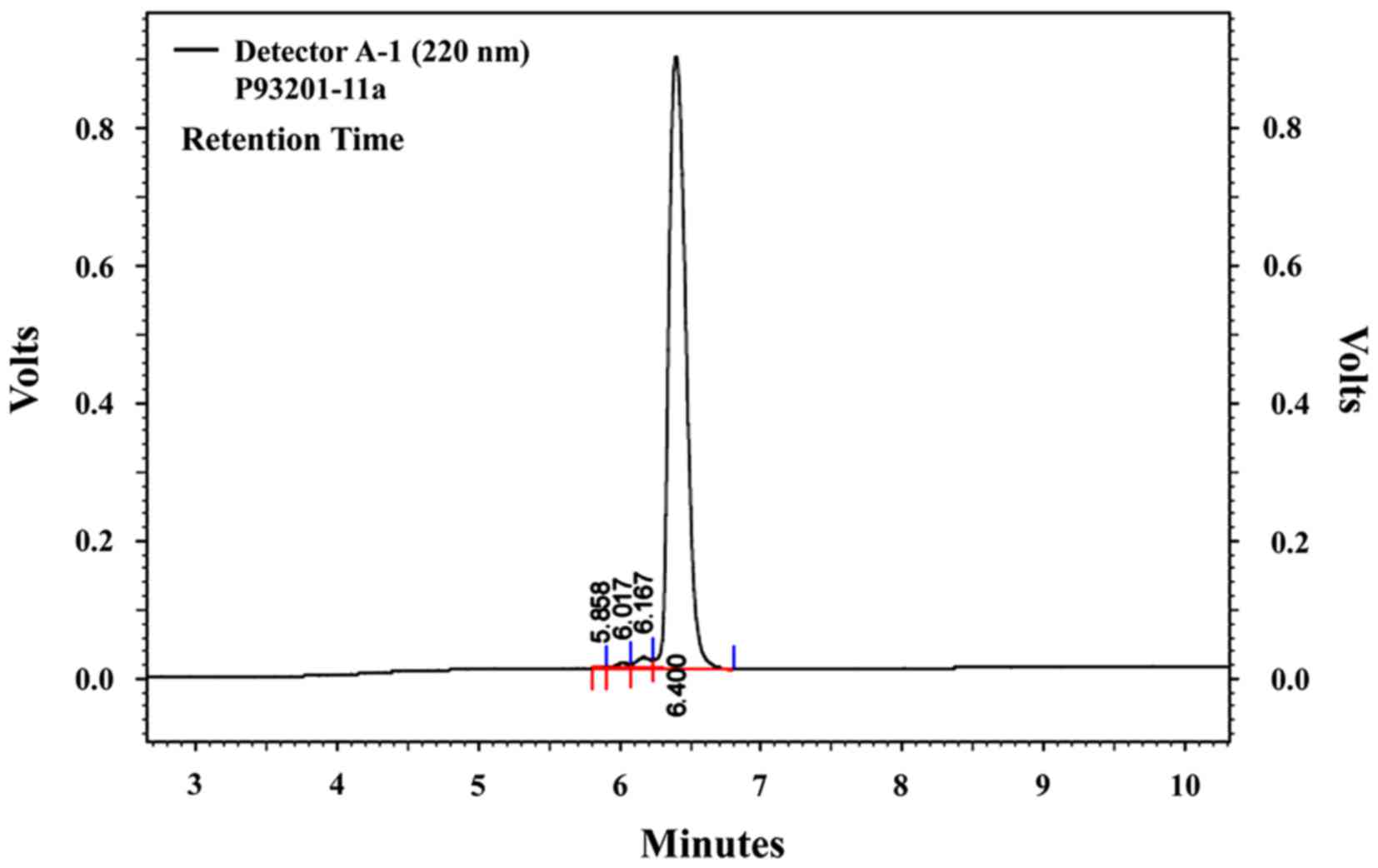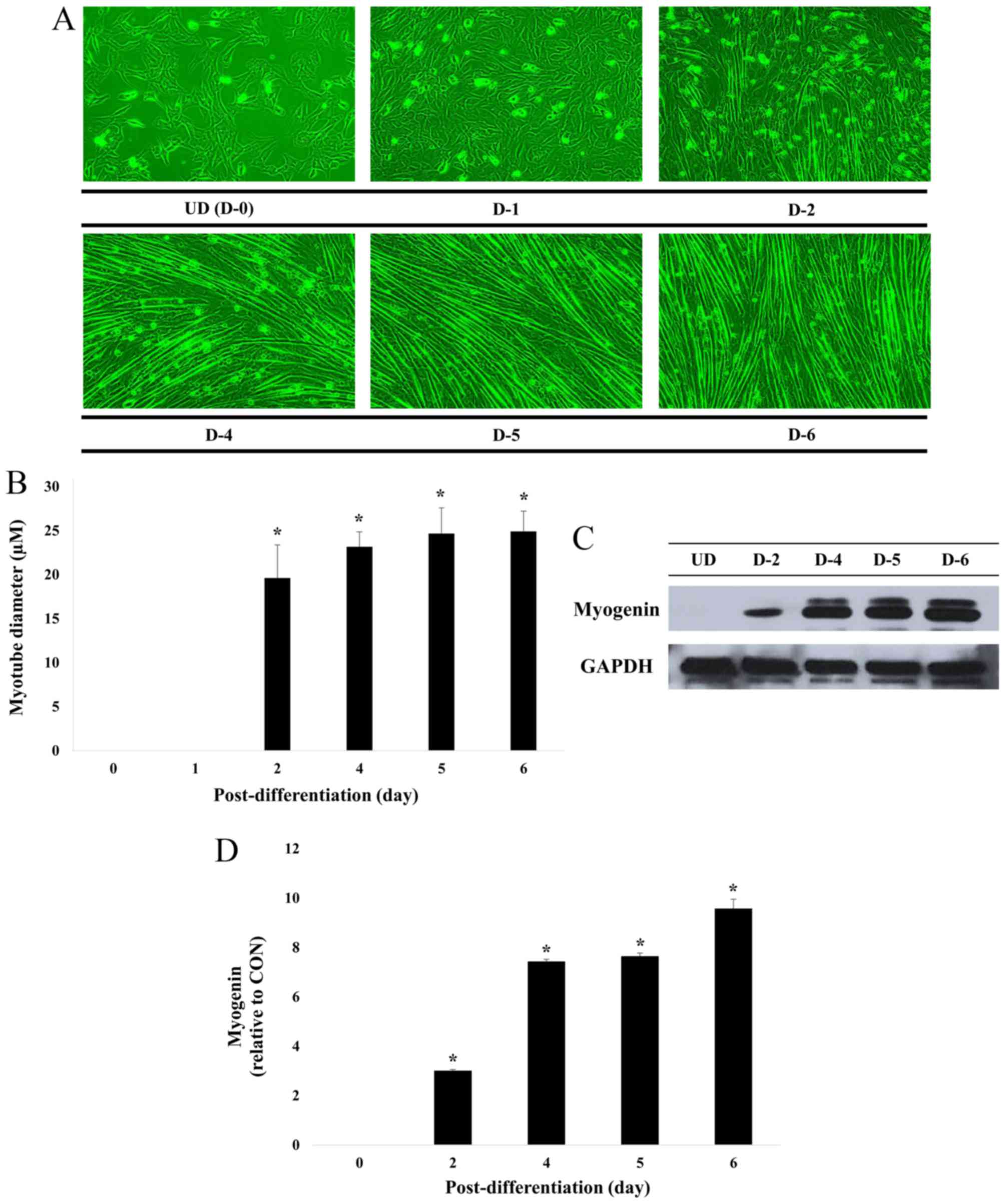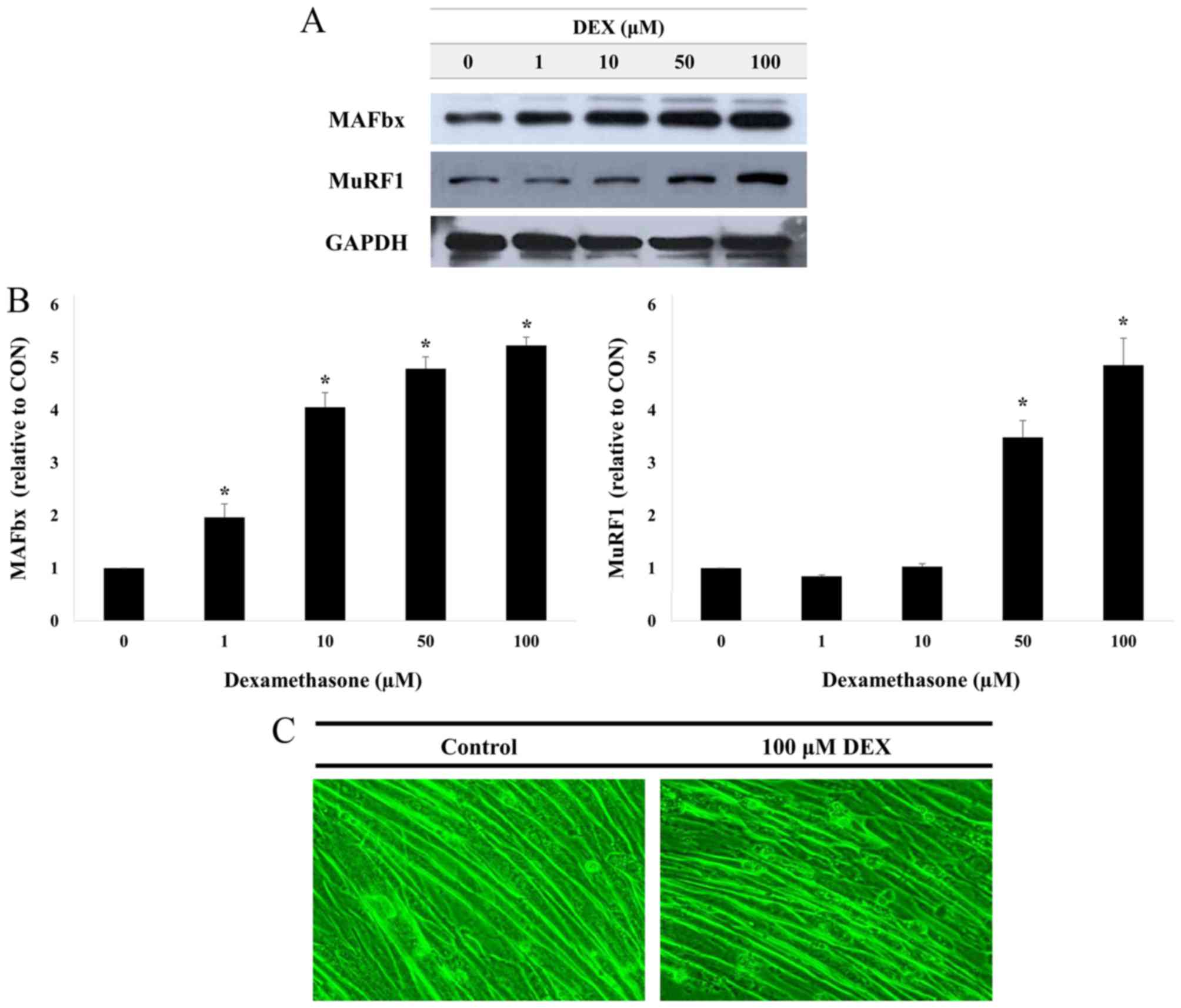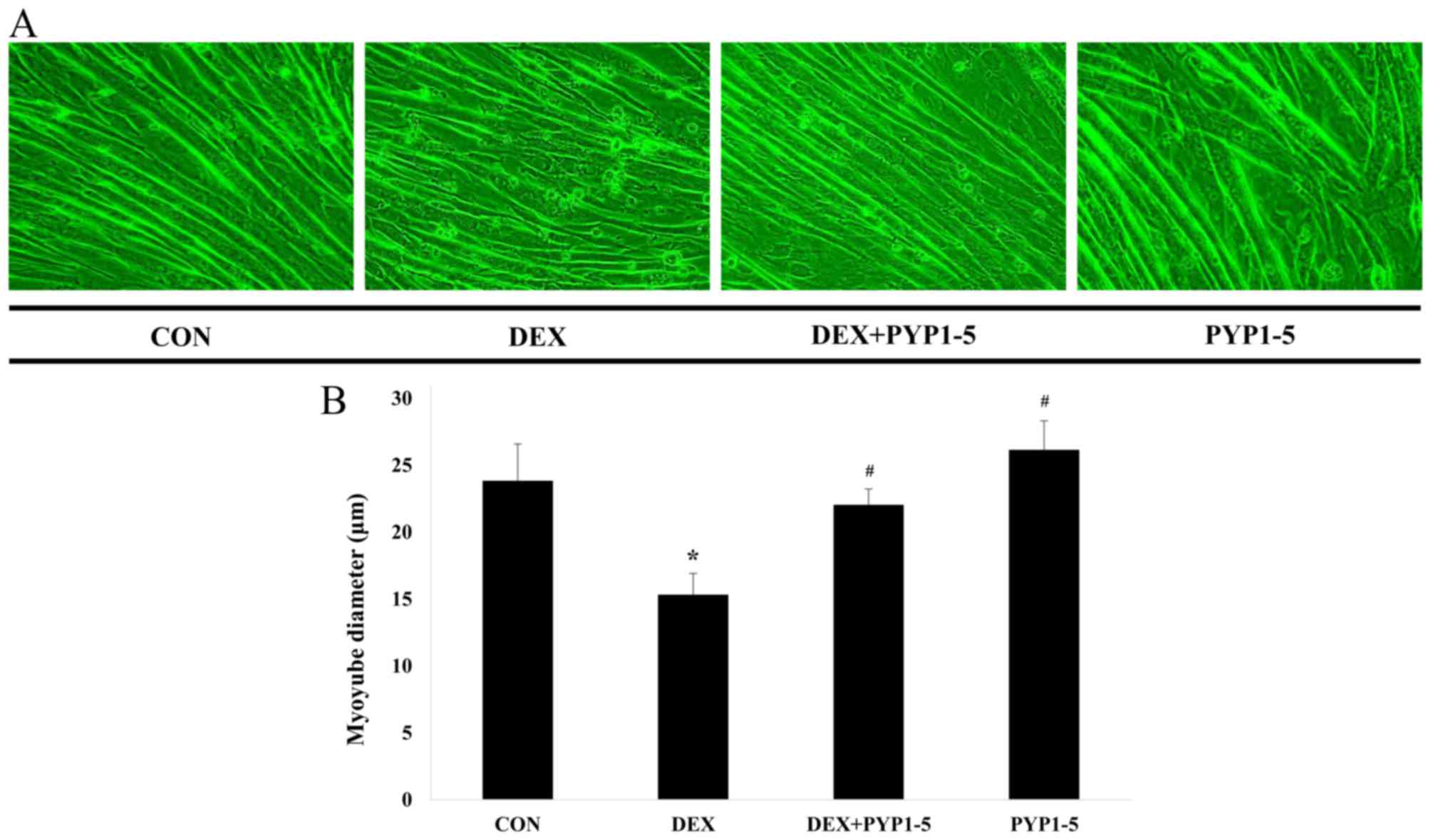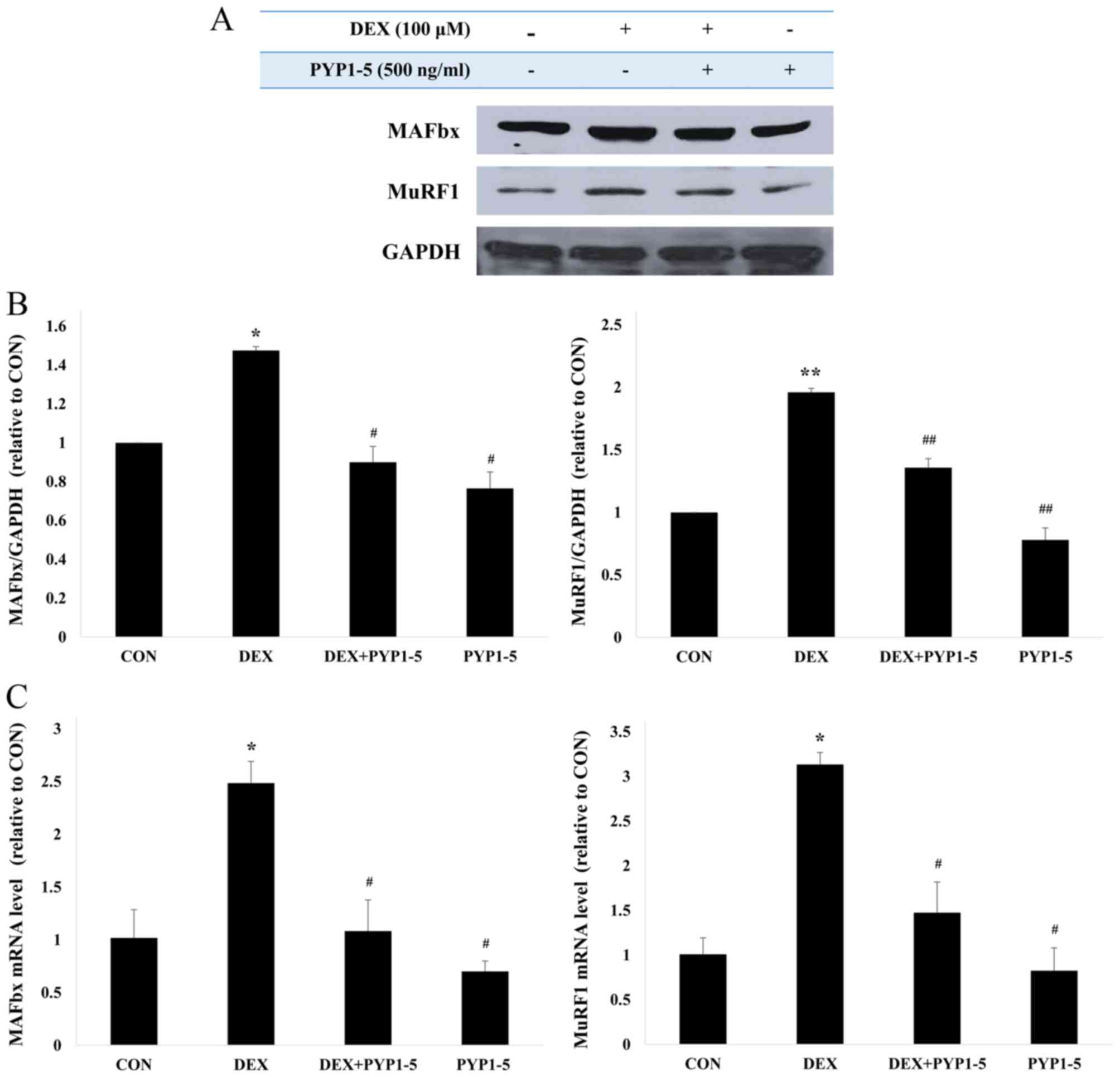Pyropia yezoensis peptide PYP1‑5 protects against dexamethasone‑induced muscle atrophy through the downregulation of atrogin1/MAFbx and MuRF1 in mouse C2C12 myotubes
- Authors:
- Published online on: April 7, 2017 https://doi.org/10.3892/mmr.2017.6443
- Pages: 3507-3514
-
Copyright: © Lee et al. This is an open access article distributed under the terms of Creative Commons Attribution License.
Abstract
Introduction
Pyropia yezoensis, a marine red alga previously known as Porphyra yezoensis, is a commercially important seaweed in a number of Asian countries, including Korea, China, and Japan. P. yezoensis is a crucial source of bioactive substances that contain large quantities of essential proteins, vitamins and minerals. P. yezoensis has potentially beneficial biological effects, including anti-inflammatory, antioxidant, anticancer, anti-fatigue and anti-aging (1,2).
Aging is a multifactorial process that is facilitated by a decline in neuromuscular functions and stress tolerance, which results in tissue degeneration and malfunction, most notably in the skeletal muscles. Age-related muscle atrophy and a reduction in skeletal muscle mass and strength is a condition known as sarcopenia (from the Greek for ‘lack of flesh’). Sarcopenia leads to muscle weakness and greatly affects physical activity and the quality of life of elderly individuals (3,4); sarcopenia is common in elderly people, and is estimated to occur in 5–13% of people aged 60–70 years and in 11–50% of those ≥80 years (5). The mechanisms of sarcopenia development are actively being studied and involve both intrinsic and extrinsic factors, including the decline of satellite cell activation, altered hormonal status, contraction-induced injury, cellular vacuolization, autophagy, apoptosis and increased oxidative stress (6).
C2C12 mouse skeletal muscle cells are an in vitro model that is widely used to study the factors that regulate muscle growth, proliferation and differentiation (7). The differentiation of myotubes can be induced by 2% fetal bovine serum (FBS). Previous studies have demonstrated that C2C12 myoblasts cultured in a growth-factor-deficient state causes the mononucleated myoblasts to exit the cell cycle, which activates the expression of genes that promote myoblast fusions and the formation of multinucleated myotubes (8,9). During this process, changes in cell shape along with cell fusion occur, and myotube phenotypes can be observed within 5–6 days. In addition, when muscle fiber formation (myogenesis) begins, myogenic transcriptional regulatory factors belonging to the MyoD family, including MyoD, myogenin, Myf4 and Myf5, are activated (10). Amongst these, myogenin has an important role within the MyoD family as it regulates the differentiation of single nucleated myoblasts into multinucleated myofibers (11).
Glucocorticoids are important in the development of muscle atrophy in humans and animals (12). In both in vivo and in vitro experiments, muscle atrophy is induced by synthetic glucocorticoids such as dexamethasone (DEX) (12). In skeletal muscles, DEX causes a reduction in protein synthesis and an increase in protein degradation through the ubiquitin-proteasome pathway (13). The ubiquitin-proteasome pathway has been revealed to mediate the degradation of short-lived proteins and long-lived myofibrillar proteins (14). This protein-degradation system comprises three enzymatic components: the ubiquitin-activating E1 enzyme, the ubiquitin-conjugating E2 enzyme and the ubiquitin-ligating E3 enzyme. E3 ubiquitin ligases serve a crucial role in identifying and targeting proteins for proteasomal degradation (14,15). A previous study characterized two muscle-specific E3 ubiquitin ligases, muscle RING-finger 1 (MuRF1) and muscle atrophy F-box (MAFbx; also known as atrogin1), as markers of skeletal muscle atrophy (16). Levels of MuRF1 and atrogin1/MAFbx expression are induced early in the atrophy process, prior to the loss of muscle mass (16). The expression of atrogin1/MAFbx is controlled by forkhead box O, whereas MuRF1 transcription is controlled by nuclear factor κB (17).
The present study investigated the potential protective effects of the P. yezoensis peptide PYP1-5 on DEX-induced muscle atrophy in C2C12 mouse skeletal muscle cells, based on the efficacy of P. yezoensis muscle contraction and release. The synthetic peptide PYP1-5 corresponds to the 15 N-terminal residues of PYP1 (ALEGGKSSGGGEATRDPEPT) (18). The anti-atrophy potential of PYP1-5 was determined by focusing on its effects on the expression of atrogin1/MAFbx and MuRF1.
Materials and methods
P. yezoensis peptide synthesis
The N-terminal 15 residues of P. yezoensis peptide PYP1 (1–15) (D-P-K-G-K-Q-Q- A-I-H-V-A-P-S-F; designated as PYP1-5) were synthesized by Peptron (Daejeon, Korea). PYP1-5 purification was performed using a Prominence High-Performance Liquid Chromatography apparatus (Shimadzu Corporation, Kyoto, Japan) with a Capcell Pak C18 column (column dimensions, 150×4.6 mm; particle size, 2.7 µm; Shiseido Co., Ltd., Tokyo, Japan) in 0.1% trifluoroacetic acid (TFA; v/v in water), and an elution gradient of 10–70% acetonitrile (0–20% acetonitrile for 2 min; 20–50% acetonitrile for 10 min; 50–80% acetonitrile for 2 min) in 0.1% TFA, a flow rate of 1.0 ml/min and UV detection at 220 nm; analysis was conducted with the Class-VP software package, version 6.14 (Shimadzu Corporation). The molecular mass of PYP1-5 was confirmed to be 1,622 Da (Fig. 1) using an HP 110 Series LC/MSD mass spectrometer [ionization mode, positive; nitrogen flow, 7 l/min; high vacuum, 1.3E-5 torr; neb press, 40 psi; quadrupole temperature, 100°C; flow rate, 0.4 ml/min (isocratic ANC:DW=8:2, 0.1% TFA); Peptron, Inc., Daejeon, Korea].
Cell culture
C2C12 mouse skeletal muscle cells (ATCC no. CRL-1772; American Type Culture Collection, Manassas, VA, USA) were cultured in Dulbecco's modified Eagle's medium (DMEM; Gibco; Thermo Fisher Scientific, Inc., Waltham, MA, USA) supplemented with 10% FBS (Gibco; Thermo Fisher Scientific, Inc.), 100 U/ml penicillin and 100 mg/ml streptomycin (Gibco; Thermo Fisher Scientific, Inc.) at a temperature of 37°C in a humidified atmosphere of 5% CO2. The cells were cultured to 70–80% confluence in 100 mm dishes, and the medium was replaced every 2 days.
Induction of differentiation
C2C12 myoblasts were grown to 70–80% confluence in culture dishes at 37°C, trypsinized and seeded (4×104 cells/well) into 6-well culture plates for experiments. Cells were grown to 70–80% confluence in DMEM supplemented with 10% FBS at 37°C for 24 h, at which time the medium was replaced with DMEM containing 2% FBS to induce myotube differentiation; the medium was replaced every 2 days. Cells were allowed to differentiate for 6 days, at which point 90% of the cells had fused into myotubes.
Treatment with DEX and PYP1-5
Following 6 days of differentiation, C2C12 myotubes were treated with 1, 10, 50 or 100 µM DEX at 37°C for 24 h for concentration screening. The C2C12 myotubes were subdivided into four groups: i) the control group, in which cells were incubated in serum-free medium (SFM; DMEM containing 100 U/ml penicillin and 100 mg/ml streptomycin); ii) the DEX group, in which cells were treated with 100 µM DEX; iii) the DEX+PYP1-5 group, in which cells were treated with 100 µM DEX and 500 ng/ml PYP1-5; and iv) the PYP1-5 group, in which cells were treated with 500 ng/ml PYP1-5. All groups were incubated at 37°C for 24 h, prior to harvesting cells for experiments.
MTS assay
Cell viability was measured using the CellTiter 96 AQueous Non-Radioactive Cell Proliferation assay (Promega Corporation, Madison, WI, USA), which is based on the cleavage of 3-(4,5-dimethythiazol-2-yl)-5-(3-carboxymethoxyphenyl)-2-(4-sulfonyl)-2H-tetrazolium (MTS) into a formazan product that is soluble in tissue culture medium, according to the manufacturer's protocol. Cells (1.5×104 cells/well) were seeded in 96-well plates in 100 µl DMEM supplemented with 10% FBS and were allowed to attach at 37°C for 24 h. Attached cells were maintained in SFM at 37°C for 4 h and were subsequently treated with or without PYP1-5 (125, 250, 500 and 1,000 ng/ml) for 24 h. MTS solution (10 µl) was added and the cells were incubated at 37°C for 30 min; the absorbance of each well was measured at 490 nm using a SpectraMax 340 PC Microplate Reader (Molecular Devices, LLC, Sunnyvale, CA, USA). Experiments were performed in triplicate.
Measurement of myotube diameter
Images of myotube cultures were captured with a phase contrast microscope set to ×100 magnification at 1, 2, 4, 5 and 6 days following induction of differentiation. Images of myotube cultures were also captured following treatment with 100 µM DEX and/or 500 ng/ml PYP1-5 for 24 h. A total of 50 myotube diameters from at least 10 random fields were measured using ImageJ software (version 4.16; National Institutes of Health, Bethesda, MD, USA).
Preparation of whole-cell protein lysates
Cells were allowed to differentiate for 6 days at 37°C, followed by incubation at 37°C for 24 h in either SFM (control group) or SFM containing 100 µM DEX (DEX group), 100 µM DEX + 500 ng/ml PYP1-5 (DEX+PYP1-5 group) or 500 ng/ml PYP1-5 (PYP1-5 group). Cells were washed in cold phosphate-buffered saline (PBS) and lysed with extraction buffer [1% NP-40, 0.25% sodium deoxycholate, 1 mM ethylene glycol-bis (β-aminoethyl ether)-N, N,N', N'-tetraacetic acid, 150 mM NaCl, 50 mM Tris-HCl, pH 7.5] containing protease inhibitors (1 mg/ml aprotinin, 1 mg/ml leupeptin, 1 mg/ml pepstatin A, 200 mM Na3VO4, 500 mM NaF and 100 mM phenylmethylsulfonyl fluoride) on ice. Extracts were centrifuged at 18,341 × g for 10 min at 4°C, and protein levels were quantified using a Bicinchoninic acid protein assay kit (Pierce; Thermo Fisher Scientific, Inc.) according to the manufacturer's instructions. The supernatant was then used in western blotting.
Extraction of nuclear lysates
Cell were treated and harvested as aforementioned, lysed with hypotonic lysis buffer [25 mM 4-(2-hydroxyethyl)-1-piperazineethanesulphonic acid (HEPES; pH 7.5), 5 mM EDTA, 5 mM MgCl2 and 5 mM dithiothreitol (DTT)], and incubated for 15 min on ice. NP-40 (2.5%) was added and the cells were lysed for an additional 10 min. Nuclei were collected by centrifugation at 7,310 × g for 15 min at 4°C. Nuclear proteins were resuspended in extraction buffer (10 mM HEPES pH 7.9, 100 mM NaCl, 1.5 mM MgCl2, 0.1 mM EDTA and 0.2 mM DTT) and incubated for 20 min at 4°C. Extracts were centrifuged at 18,341 × g for 10 min, and the protein levels were determined using a Bicinchoninic acid protein assay kit (Pierce; Thermo Fisher Scientific, Inc.) according to the manufacturer's instructions. The supernatant was used then for western blot analysis.
Western blot analysis
Proteins (20 µg) were separated by 10% sodium dodecyl sulfate-polyacrylamide gel electrophoresis (SDS-PAGE) and transferred to polyvinylidene fluoride membranes (EMD Millipore, Billerica, MA, USA). Membranes were blocked at room temperature for 1 h with 1% bovine serum albumin (BSA) in TBS-T (10 mM Tris-HCl, 150 mM NaCl and 0.1% Tween-20) and then incubated with primary antibodies against Myogenin, MuRF1, MAFbx and GAPDH (Table I; all purchased from Santa Cruz Biotechnology, Inc., Dallas, TX, USA) at room temperature for 3 h. Membranes were incubated with secondary horseradish peroxidase-conjugated rabbit anti-goat IgG, goat anti-mouse IgG (both Santa Cruz Biotechnology, Inc.) and goat anti-rabbit IgG (Cell Signaling Technology, Inc., Danvers, MA, USA; Table II) at room temperature for 1 h and bands were detected using an enhanced chemiluminescence western blotting kit (Thermo Fisher Scientific, Inc.). Experiments were performed in triplicate and densitometry analysis was performed using Multi-Gauge software version 3.0 (Fujifilm Life Science, Tokyo, Japan).
Reverse transcription-quantitative polymerase chain reaction (RT-qPCR)
Total RNA was extracted from C2C12 cells (4×104 cells/well) using TRIzol Reagent (Invitrogen; Thermo Fisher Scientific, Inc.). RNA quality was evaluated by measuring absorbance at 260 and 280 nm to calculate concentration and to assess RNA purity. The RevoScript Reverse Transcriptase PreMix (oligo dT) kit (Intron Biotechnology, Inc., Seongnam, Korea) was used to prepare cDNA, according to the manufacturer's protocol, and the samples were stored at −50°C. qPCR was conducted in 20 µl reactions using the QuantiMix SYBR kit (PhilKorea Technology, Inc., Daejeon, Korea) and the Eco Real-Time PCR System (Illumina, Inc., San Diego, CA, USA), following the manufacturer's protocol. Oligonucleotide primers for MuRF1, atrogin1/MAFbx and GAPDH are shown in Table III. qPCR reactions were incubated for an initial denaturation at 95°C for 10 min, followed by 40 cycles of: 95°C for 15 sec, 55°C for 15 sec, and 72°C for 15 sec. For each sample, the expression level of target mRNA was quantified to those of GAPDH mRNA and calculated using the comparative ΔΔCq method (19). All reactions were performed in triplicate and repeated in two independent experiments.
Table III.Oligonucleotide primer sequences used in reverse transcription-quantitative polymerase chain reactions. |
Statistical analysis
Multiple mean values were assessed by analysis of variance using SPSS version 10.0 software (SPSS Inc., Chicago, IL, USA) using one-way analysis of variance followed by a Duncan's multiple range test. P<0.05 was considered to indicate a statistically significant difference.
Results
Confirmation of C2C12 myotube differentiation
C2C12 skeletal muscle myoblasts were induced to differentiate in a mitogen-poor media such as 2% FBS, fusing to form multinucleate myotubes (20). Fig. 2 illustrates that the cell diameter remained similar following 4, 5 and 6 days of differentiation. In addition, the level of myogenin expression, a factor that regulates terminal differentiation of muscle cells, was similar following 4 and 5 days then increased following 6 days. These results indicate complete differentiation of myoblasts into myotubes at this time (6 days).
DEX-induced muscle atrophy in C2C12 myotubes
MuRF1 and atrogin1/MAFbx protein expression levels were measured in C2C12 myotubes treated with 1, 10, 50 or 100 µM DEX for 24 h (Fig. 3A and B). Treatment with DEX led to increased protein expression levels for MuRF1 and atrogin1/MAFbx, and the levels of expression increased in a dose-dependent manner. These data suggest that DEX may induce muscle atrophy in C2C12 myotubes. In addition, as shown in Fig. 3C, when compared with the control group, the C2C12 myotube was markedly atrophied in the 100 µM DEX-treated group. Therefore, all further experiments were performed following treatment with 100 µM DEX.
Toxicity of PYP1-5 in C2C12 myoblast
Through mass spectrometry, we identified a 1,622 Da compound from P. yezoensis, which we named PYP1-5 (Fig. 1). The MTS assay was used to determine PYP1-5 cytotoxicity to C2C12 myoblasts, which demonstrated no cytotoxic effects following PYP1-5 treatment for 24 h (Fig. 4). Therefore, all further experiments were performed 24 h following treatment with 500 ng/ml PYP1-5, which is the optimum concentration without toxicity as described by Choi et al (18).
Inhibitory effect of PYP1-5 on DEX-induced myotube atrophy
C2C12 myotubes were allowed to differentiate for 6 days, followed by 100 µM DEX and/or 500 ng/ml PYP1-5 treatment for a further 24 h. As a result, when compared with the control group, the DEX-treated group exhibited a 36% reduction in cell diameter, whereas the PYP1-5-treated group exhibited a 10% increase in cell diameter. In addition, DEX-induced reduction of cell diameter was suppressed by co-treatment with PYP1-5 (Fig. 5A and B). The anti-atrophic effects of PYP1-5 were investigated by examining the protein and mRNA expression levels of the muscle atrophy markers MuRF1 and atrogin1/MAFbx in C2C12 myotubes that were treated with 100 µM DEX and 500 ng/ml PYP1-5 for 24 h (Fig. 6). Cells treated with DEX alone exhibited a marked increase in the mRNA and protein expression levels of MuRF1 and atrogin1/MAFbx compared with cells in the untreated control group (Fig. 6). The DEX-induced upregulation of MuRF1 and atrogin1/MAFbx was suppressed by co-treatment with 500 ng/ml PYP1-5. Therefore, PYP1-5 may be able to inhibit atrophy and induce hypertrophy pathways in C2C12 myotubes.
Discussion
Skeletal muscle atrophy refers to the decline in muscle mass and strength that may occur as a result of various conditions, including denervation, injury, glucocorticoid treatment, starvation, cancer, joint immobilization, sepsis and aging (21). The present study focused on the progression of muscle atrophy caused by aging.
In the present study, anti-atrophic effects of the P. yezoensis peptide PYP1-5 were investigated in C2C12 myotubes. C2C12 mouse skeletal muscle cells are commonly used as a model for myotube differentiation to examine the signaling pathways involved in muscle atrophy. The effects of the PYP1-5 on the muscle atrophy in C2C12 myotubes were determined by first culturing C2C12 myoblasts in media containing 2% FBS for 6 days to induce differentiation. Following differentiation, muscle atrophy was induced by treating the cells with DEX. DEX treatment has been previously demonstrated to reduce muscle mass, largely owing to the breakdown of muscle proteins due to upregulated catabolism by the ubiquitin-proteasome system (22,23). Administration of high concentrations of DEX has been revealed to cause muscle atrophy in animals and humans (24). Results from the present study demonstrated that C2C12 myotubes respond to increasing concentrations of DEX (1–100 µM) in a dose-dependent manner, as revealed by the increased expression of MuRF1 and atrogin1/MAFbx protein levels. Prior to determining the protective effects of PYP1-5 on muscle atrophy, the potential toxicity of PYP1-5 on C2C12 myoblasts was determined using an MTS assay, which revealed that PYP1-5 treatment had no cytotoxic effects on C2C12 myoblasts. We next assessed the protective effects of PYP1-5 by measuring myotube diameter. Compared with the control group, the DEX-treated group exhibited a 36% reduction in cell diameter, whereas the PYP1-5-treated group exhibited a 10% increase in cell diameter. Subsequently, the effects of PYP1-5 on C2C12 myotube atrophy were investigated by examining the expression levels of muscle atrophy markers MuRF1 and atrogin1/MAFbx, as they are upregulated in a number of catabolic conditions (25). Glucocorticoids such as DEX have been demonstrated to promote myosin heavy chain degradation through the activation of the E3 ligase MuRF1 (26). Therefore, the downregulation of MuRF1 and atrogin1/MAFbx expression may inhibit muscle atrophy. Western blot and RT-qPCR analyses in the present study revealed that PYP1-5 treatment led to a decrease in the mRNA and protein expression levels of MuRF1 and atrogin1/MAFbx, suggesting that PYP1-5 may potentially be used in anti-atrophy functional foods.
In conclusion, the present study provides important new information about the influence of PYP1-5 on DEX-induced muscle atrophy. The results provide molecular evidence that the anti-atrophic effects of PYP1-5 are due to the downregulated expression of the muscle-specific E3 ubiquitin ligases MuRF1 and atrogin1/MAFbx. Future studies on the anti-atrophic effects of PYP1-5 are required, and should involve identifying the signaling pathways that may be associated with the anti-atrophic effects, such as insulin-like growth factor 1/Akt and myostatin.
Acknowledgements
The present study was supported by the Basic Science Research Program through the National Research Foundation of Korea funded by the Ministry of Education (grant no. 2012R1A6A1028677).
References
|
Byeon Y, Lee H Yool, Choi DW and Back K: Chloroplast-encoded serotonin N-acetyltransferase in the red alga Pyropia yezoensis: Gene transition to the nucleus from chloroplasts. J Exp Bot. 66:709–717. 2015. View Article : Google Scholar : PubMed/NCBI | |
|
Lee MK, Kim IH, Choi YH, Choi JW, Kim YM and Nam TJ: The proliferative effects of Pyropia yezoensis peptide on IEC-6 cells are mediated through the epidermal growth factor receptor signaling pathway. Int J Mol Med. 35:909–914. 2015.PubMed/NCBI | |
|
Wenz T, Rossi SG, Rotundo RL, Spiegelman BM and Moraes CT: Increased muscle PGC-1alpha expression protects from sarcopenia and metabolic disease during aging. Proc Natl Acad Sci USA. 106:pp. 20405–20410. 2009; View Article : Google Scholar : PubMed/NCBI | |
|
Doherty TJ: Invited Review: Aging and sarcopenia. J Appl Physiol (1985). 95:1717–1727. 2003. View Article : Google Scholar : PubMed/NCBI | |
|
Marzetti E and Leeuwenburgh C: Skeletal muscle apoptosis, sarcopenia and frailty at old age. Exp Gerontol. 41:1234–1238. 2006. View Article : Google Scholar : PubMed/NCBI | |
|
Dupont-Versteegden EE: Apoptosis in muscle atrophy: Relevance to sarcopenia. Exp Gerontol. 40:473–481. 2005. View Article : Google Scholar : PubMed/NCBI | |
|
Artaza JN, Bhasin S, Mallidis C, Taylor W, Ma K and Gonzalez-Cadavid NF: Endogenous expression and localization of myostatin and its relation to myosin heavy chain distribution in C2C12 skeletal muscle cells. J Cell Physiol. 190:170–179. 2002. View Article : Google Scholar : PubMed/NCBI | |
|
Aoki MS, Miyabara EH, Soares AG, Saito ET and Moriscot AS: mTOR pathway inhibition attenuates skeletal muscle growth induced by stretching. Cell Tissue Res. 324:149–156. 2006. View Article : Google Scholar : PubMed/NCBI | |
|
Weintraub H: The MyoD family and myogenesis: Redundancy, networks, and thresholds. Cell. 75:1241–1244. 1993. View Article : Google Scholar : PubMed/NCBI | |
|
Melo F, Carey DJ and Brandan E: Extracellular matrix is required for skeletal muscle differentiation but not myogenin expression. J Cell Biochem. 62:227–239. 1996. View Article : Google Scholar : PubMed/NCBI | |
|
te Pas MF, Soumillion A, Harders FL, Verburg FJ, van den Bosch TJ, Galesloot P and Meuwissen TH: Influences of myogenin genotypes on birth weight, growth rate, carcass weight, backfat thickness, and lean weight of pigs. J Anim Sci. 77:2352–2356. 1999. View Article : Google Scholar : PubMed/NCBI | |
|
Sandri M, Sandri C, Gilbert A, Skurk C, Calabria E, Picard A, Walsh K, Schiaffino S, Lecker SH and Goldberg AL: Foxo transcription factors induce the atrophy-related ubiquitin ligase atrogin-1 and cause skeletal muscle atrophy. Cell. 177:399–412. 2004. View Article : Google Scholar | |
|
Zhao W, Qin W, Pan J, Wu Y, Bauman WA and Cardozo C: Dependence of dexamethasone-induced Akt/FOXO1 signaling, upregulation of MAFbx, and protein catabolism upon the glucocorticoid receptor. Biochem Biophys Res Commun. 378:668–672. 2009. View Article : Google Scholar : PubMed/NCBI | |
|
Glass DJ: Skeletal muscle hypertrophy and atrophy signaling pathways. Int J Biochem Cell Biol. 37:1974–1984. 2005. View Article : Google Scholar : PubMed/NCBI | |
|
Hershko A and Ciechanover A: The ubiquitin system. Annu Rev Biochem. 67:425–479. 1998. View Article : Google Scholar : PubMed/NCBI | |
|
Lecker SH, Jagoe RT, Gilbert A, Gomes M, Baracos V, Bailey J, Price SR, Mitch WE and Goldberg AL: Multiple types of skeletal muscle atrophy involve a common program of changes in gene expression. FASEB J. 18:39–51. 2004. View Article : Google Scholar : PubMed/NCBI | |
|
Meng SJ and Yu LJ: Oxidative stress, molecular inflammation and sarcopenia. Int J Mol Sci. 11:1509–1526. 2010. View Article : Google Scholar : PubMed/NCBI | |
|
Choi YH, Yamaguchi K, Oda T and Nam TJ: Chemical and mass spectrometry characterization of the red alga Pyropia yezoensis chemoprotective protein (PYP): Protective activity of the N-terminal fragment of PYP1 against acetaminophen-induced cell death in Chang liver cells. Int J Mol Med. 35:271–276. 2015.PubMed/NCBI | |
|
Livak KJ and Schmittgen TD: Analysis of relative gene expression data using real-time quantitative PCR and the 2(−Delta Delta C(T)) method. Methods. 25:402–408. 2001. View Article : Google Scholar : PubMed/NCBI | |
|
Cooper ST, Maxwell AL, Kizana E, Ghoddusi M, Hardeman EC, Alexander IE, Allen DG and North KN: C2C12 co-culture on a fibroblast substratum enables sustained survival of contractile, highly differentiated myotubes with peripheral nuclei and adult fast myosin expression. Cell Motil Cytoskeleton. 58:200–211. 2004. View Article : Google Scholar : PubMed/NCBI | |
|
Gomes MD, Lecker SH, Jagoe RT, Navon A and Goldberg AL: Atrogin1, a muscle-specific F-box protein highly expressed during muscle atrophy. Proc Natl Acad Sci USA. 98:pp. 14440–14445. 2001; View Article : Google Scholar : PubMed/NCBI | |
|
Auclair D, Garrel DR, Zerouala A Chaouki and Ferland LH: Activation of the ubiquitin pathway in rat skeletal muscle by catabolic doses of glucocorticoids. Am J Physiol. 272:C1007–C1016. 1997.PubMed/NCBI | |
|
Jackman RW and Kandarian SC: The molecular basis of skeletal muscle atrophy. Am J Physiol. 287:C834–C843. 2004. View Article : Google Scholar | |
|
Mitch WE and Goldberg AL: Mechanisms of muscle wasting. The role of the ubiquitin-proteasome pathway. N Engl J Med. 335:1897–1905. 1996. View Article : Google Scholar : PubMed/NCBI | |
|
Krawiec BJ, Nystrom GJ, Frost RA, Jefferson LS and Lang CH: AMP-activated protein kinase agonists increase mRNA content of the muscle-specific ubiquitin ligases MAFbx and MuRF1 in C2C12 cell. Am J Physiol Endocrinol Metab. 292:E1555–E1567. 2007. View Article : Google Scholar : PubMed/NCBI | |
|
Clarke BA, Drujan D, Willis MS, Murphy LO, Corpina RA, Burova E, Rakhilin SV, Stitt TN, Patterson C, Laltres E and Glass DJ: The E3 ligase MuRF1 degrades myosin heavy chain protein in dexamethasone-treated skeletal muscle. Cell Metab. 6:376–385. 2007. View Article : Google Scholar : PubMed/NCBI |



